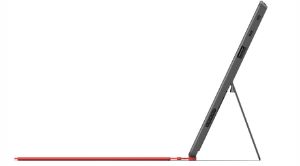Give Microsoft credit for making the burgeoning tablet wars interesting again.
Just when you thought Apple’s iPad was going to run away with first prize – or every prize, for that matter – the Redmond software giant pulls some slick-looking hardware out of its labs and throws down the gauntlet. If it isn’t game on, it’s mighty close.
Microsoft calls its wannabe-iPad killer the Surface, and at first glance it’s an impressive slab of technology that boasts the kind of refined industrial design that’s made anything with a fruit on it the object of endless fanboy desire.
It includes an innovative cover that protects the screen and adds, quite unexpectedly, a built-in multi-touch keyboard on the inside. Open it up and start hammering out War and Peace. Sure, you can buy a third-party keyboard case for your iPad, but this is a cleaner solution for users who want to use their tablets for more than watching videos and surfing the web.
It sports a 10.6-inch, full-HD screen – bigger than the iPad’s 9.7-inch panel – and unlike Apple’s sealed-in device, includes USB and external display ports.
What does all this tech talk mean? The Surface is a seriously capable tablet that one-ups the iPad in a number of key areas.
Related on the Web:
Microsoft’s big reveal
Microsoft’s decision to leap head-first into making its own hardware is a bold move designed to sidestep its traditional model of licensing its software to hardware partners. Microsoft’s new religion, which mimics Apple’s build-it-all philosophy, means the software can be more tightly integrated into the hardware, and Microsoft isn’t stuck living with its hardware partners’ decisions. That reality has hobbled Windows for the better part of two decades, with PC builders often adding in layers of advertising-heavy, value-deficient software that clutter the experience and frustrate users.
By bypassing middlemen like HP, Toshiba and Samsung – and risking their newly-competitive wrath in the process – Microsoft calls all the shots, and lives and dies with the results. It’s a risk worth taking given how crucial these devices and the upcoming next-generation Windows launches are to the company’s future.
As so often seems to be the case with Microsoft, however, its sheer ambition and capability may have put its aspirations in the hole before they have a chance to see the light of day. First is its decision to split the line by selling two distinct models. A commercially-focused Windows 8 tablet will run on familiar Intel-based processors – the same basic architecture that’s been powering PCs for decades – and will support Windows programs. Have a copy of Word or Excel lying around? Congratulations, it now runs on a tablet.
A consumer-oriented model, based on the ARM processors that underpin today’s most popular tablets and smartphones, is a bit of a different animal. It runs something called Windows RT, and your old software won’t work on it.
Apple seems to sell its one line of iPads just fine into both consumer and enterprise channels. The bring your own device trend in which regular users buy personal technology like tablets and smartphones on Sunday, then walk them into the office on Monday and demand IT hook them up, is rendering traditional divisions between consumer and corporate devices moot. Microsoft’s decision to separately target these two worlds only serves to confuse buyers and frustrate developers.
Yes, developers. The folks who will make or break the Surface before it hits its first retail shelf. Forcing them to choose between traditional Windows development and untried, untested Windows RT isn’t going to go over well. Programmers like simple, and this isn’t simple. And if they hesitate to dive in and create new apps for either platform, all the fantastic hardware in the world won’t save Microsoft’s tablet fortunes.
There’s no question Microsoft needed to do something bold to leapfrog beyond its roots in the PC world. Tablets are nibbling into the fringes of the traditional laptop market, Microsoft’s bread and butter. As part of a rollout strategy for its next-generation Windows 8 operating system that encompasses traditional computers, tablets, and hybrids of the two, the company couldn’t simply update the current version of Windows and call it a day.
It has offered up two compelling tablet flavours to convince the market it’s playing to win. The question remains whether it needs two flavours to begin with, and whether it’s focused so intently on the hardware it’s forgotten that earlier versions of Windows soared because a software company made it easy for programmers to develop and sell more programs than any other platform combined.
Until Microsoft simplifies its schizophrenic offerings and gives developers a reason to make the leap, its promising new hardware will remain just that: promising.
Carmi Levy is a London, Ont.-based independent technology analyst and journalist.










No comments:
Post a Comment